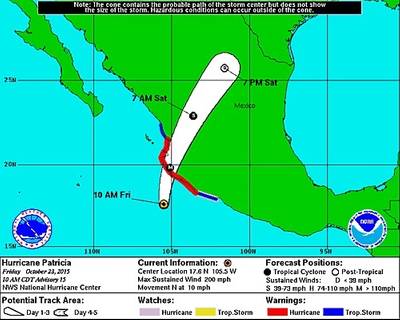Hurricane Patricia Threatens Mexico
Hurricane Patricia strengthened into one of the most powerful storms in history on Friday as it barreled toward Mexico's Pacific Coast, forcing resort hotels to evacuate tourists and residents to stockpile supplies.
The U.S. National Hurricane Center said the Category 5 storm was the strongest ever recorded in the Western Hemisphere, and the World Meteorological Organization compared it to 2013's Typhoon Haiyan, which killed thousands in the Philippines.
It was expected to make landfall on Friday afternoon or early evening, the NHC added.
Loudspeakers along the shore of the resort of Puerto Vallarta, popular with U.S. and Canadian tourists, blared orders to evacuate hotels as a light rain fell and a slight breeze ruffled palm trees. The streets emptied as police sirens wailed.
Hotel workers in Puerto Vallarta said efforts had begun to start evacuating guests, but others said they were still waiting to be told where to send them. When Reuters visited one of the city's designated shelters, a dilapidated-looking building in a low-lying area, there were still no evacuees to be found.
Aristoteles Sandoval, the governor of the state of Jalisco, expected about 15,000 people to be evacuated from Puerto Vallarta.
Mexico's communications and transport minister, Gerardo Ruiz Esparza, said the hurricane is of "colossal" proportions, and urged people to protect themselves.
"It's a danger to the coastlines, and a danger to the population," he said.
The government warned that ash and other material from the volcano of Colima, about 130 miles (210 km) from Puerto Vallarta, could combine with massive rainfall to trigger "liquid cement"-style mudflows that could envelop nearby villages.
Puerto Vallarta's airport and port were closed on Friday, while the major cargo port of Manzanillo was also shut. State oil company Pemex said service stations would stop selling gasoline in the hurricane watch area.
Local schools were closed and some business owners were busy boarding and taping up windows.
Walking his pitbull along the Puerto Vallarta boardwalk, Jesus Lopez, 60, knew how bad things could get, having lived through Hurricane Kenna, which led to evacuations of more than 20,000 people in the resort town when it crashed into Mexico's Pacific coast in 2002.
"We're worried about this hurricane because we know what can happen, and it's nothing good," he said, pointing out the low-lying areas where many of the city's inhabitants live.
Edgar Ibarra, a port official in Puerto Vallarta, said he expected the storm to start causing trouble around 8 p.m. or 9 p.m. (0100 GMT-0200 GMT) on Friday, making landfall near the small fishing town of Barra de Navidad.
Catastrophic Storm
The NHC said the damage potential was "catastrophic."
The storm grew at an "incredible rate" in the past 12 hours, the World Meteorological Organization said, and the NHC reported on Friday morning maximum sustained winds of about 200 miles per hour (321 km per hour) as it moved north at 10 mph (16 kph).
"The winds are enough to get a plane in the air and keep it flying," WMO spokeswoman Clare Nullis told a U.N. briefing in Geneva, likening it to Typhoon Haiyan.
Haiyan killed more than 6,300 people and wiped out or damaged practically everything in its path as it swept ashore on Nov. 8, 2013, destroying around 90 percent of the city of Tacloban.
The strongest storm ever recorded was Cyclone Tip which hit Japan in 1979.
Patricia was last located about 125 miles (201 km) southwest of the port of Manzanillo.
The U.S. government issued an advisory urging its nationals to steer clear of beaches and rough seas and to take shelter as instructed by Mexican officials.
None of the major installations of Mexican state oil company Pemex lie in the projected path of the storm.
(By David Alire Garcia, Additional reporting by Lizbeth Diaz, Tomas Sarmiento, Veronica Gomez and Anna Yukhananov in Mexico City and Tom Miles in Geneva)


